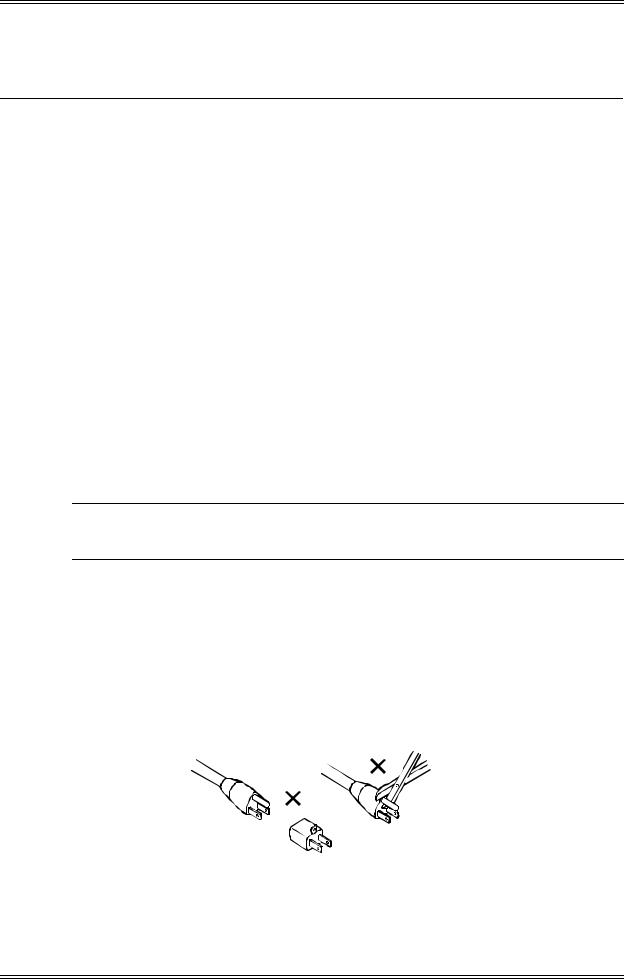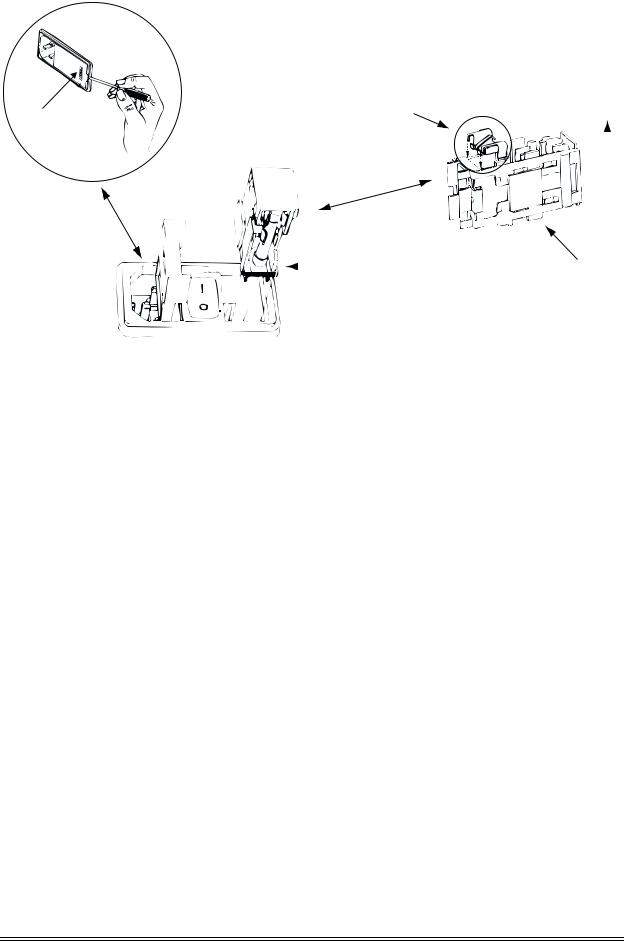Dolby Laboratories DP571, DP572 User Manual

Dolby E
Model DP571 Encoder
Model DP572 Decoder
Multichannel Distribution System
User Manual
Issue 3 |
Version 1.05 |
Part No. 91685 |

Dolby Laboratories Inc
www.dolby.com
United States
100 Potrero Avenue
San Francisco, CA 94103-4813
Telephone 415-558-0200
Facsimile 415-863-1373
United Kingdom
Wootton Bassett
Wiltshire SN4 8QJ England
Telephone (44) 1793-842100
Facsimile (44) 1793-842101
WARNING: Troubleshooting must be performed by trained technicians. Do not attempt to service this equipment unless you are qualified to do so.
DISCLAIMER OF WARRANTIES: Equipment manufactured by Dolby Laboratories is warranted against defects in materials and workmanship for a period of one year from the date of purchase. All warranties, conditions or other terms implied by statute are excluded to the fullest extent allowed by law.
LIMITATION OF LIABILITY: It is understood and agreed that Dolby Laboratories’ liability whether in contract, in tort, under any warranty, in negligence or otherwise shall not exceed the cost of repair or replacement of the defective components and under no circumstances shall Dolby Laboratories be liable for incidental, special, direct, indirect or consequential damages (including but not limited to damage to software or recorded audio or visual material), or loss of use, revenue or profit even if Dolby Laboratories or its agents have been advised, orally or in writing, of the possibility of such damages.
Dolby and the double-D symbol are registered trademarks of Dolby Laboratories.
©2000 Dolby Laboratories Inc. All rights reserved. |
S00/12805/13054 |
|
|
|
|

Table of Contents
List of Figures |
...................................................................................................................... |
|
vii |
|
List of Tables ....................................................................................................................... |
|
|
viii |
|
Preface |
Regulatory ...................................................................................Notices |
ix |
||
Chapter 1 |
Introduction ............................................................................................... |
1-1 |
||
|
1.1 ....................................................................... |
Unpacking and Inspection |
1-3 |
|
|
1.2 ............................................................................. |
System Considerations |
1-5 |
|
|
.................................................................................... |
1.2.1 |
Digital I/O |
1-5 |
|
........................................................................... |
1.2.2 |
Video Reference |
1-5 |
|
................................................................... |
1.2.3 |
Signal Characteristics |
1-5 |
|
1.3 ................................ |
Connection with the DP569 Multichannel Encoder |
1-6 |
|
|
1.4 ....................................................................... |
Front - Panel User Interface |
1-7 |
|
|
................................ |
1.4.1 Menu Selection and Push - button Operation |
1-9 |
|
|
....................................................................................... |
1.4.2 |
Display |
1-10 |
|
............................................................................. |
1.4.3 |
Display LEDs |
1-10 |
|
....................................................................................... |
1.4.4 |
Remote |
1-12 |
|
1.5 ......................................... |
Quickstart Guide for the DP571 and DP572 |
1-13 |
|
|
1.6 ......................................... |
Common Features of the DP571 and DP572 |
1-15 |
|
|
.................................................................. |
1.6.1 |
PCM Delay Channel |
1-15 |
|
..................................................................................... |
1.6.2 |
Metadata |
1-15 |
|
.................................................................................... |
1.6.3 |
Timecode |
1-15 |
|
......................................................................... |
1.6.4 |
Video Reference |
1-15 |
|
............................................................... |
1.6.5 |
Channel Configuration |
1-15 |
|
1.7 ................................................................. |
Configuring Jumper Settings |
1-16 |
|
Chapter 2 Common ......................................................Dolby E Applications |
2-1 |
|||
|
2.1 .......................................................................................................... |
Film |
|
2-1 |
|
2.2 ..................................................................... |
Commercial and Interstitial |
2-2 |
|
|
2.3 ................................................................ |
News and Local Programming |
2-2 |
|
|
2.4 ....................................................................................................... |
Music |
|
2-2 |
|
2.5 .............................................................................................. |
Live Events |
2-2 |
|
|
2.6 ......................................................................................... |
Postproduction |
2-3 |
|
iii

Chapter 3 DP571 Dolby E Encoder...................................................................... |
3-1 |
||
3.1 |
Hardware Reference ................................................................................ |
3-1 |
|
|
3.1.1 |
Digital Inputs ............................................................................... |
3-3 |
|
3.1.2 |
Video Reference........................................................................... |
3-3 |
|
3.1.3 |
LTC Input..................................................................................... |
3-3 |
|
3.1.4 |
PCM Delay Input ......................................................................... |
3-3 |
|
3.1.5 |
Metadata....................................................................................... |
3-3 |
|
3.1.6 |
Remote ......................................................................................... |
3-3 |
|
3.1.7 |
Main Out ...................................................................................... |
3-4 |
|
3.1.8 |
PCM Delay Out............................................................................ |
3-4 |
|
3.1.9 |
Status............................................................................................ |
3-4 |
|
3.1.10 |
Auxiliary ...................................................................................... |
3-5 |
|
3.1.11 |
10BASE-T.................................................................................... |
3-5 |
3.2 DP571 Setup Mode Menu Reference ...................................................... |
3-6 |
||
|
3.2.1 |
Program Config............................................................................ |
3-7 |
|
3.2.2 |
Operating Mode ........................................................................... |
3-9 |
|
3.2.3 |
Presets ........................................................................................ |
3-12 |
|
3.2.4 |
Metadata Params........................................................................ |
3-13 |
|
3.2.5 |
System Settings.......................................................................... |
3-16 |
|
3.2.6 |
Firmware Upgrade ..................................................................... |
3-16 |
3.3 DP571 Status Mode Menu..................................................................... |
3-16 |
||
Chapter 4 DP572 Dolby E Decoder...................................................................... |
4-1 |
||
4.1 |
Hardware Reference ................................................................................ |
4-1 |
|
|
4.1.1 |
Main In......................................................................................... |
4-3 |
|
4.1.2 |
Video Reference........................................................................... |
4-3 |
|
4.1.3 |
PCM Input.................................................................................... |
4-3 |
|
4.1.4 |
Remote ......................................................................................... |
4-3 |
|
4.1.5 |
Auxiliary ...................................................................................... |
4-3 |
|
4.1.6 |
10BASE-T.................................................................................... |
4-3 |
|
4.1.7 |
Metadata....................................................................................... |
4-3 |
|
4.1.8 |
Status............................................................................................ |
4-4 |
|
4.1.9 |
Digital Outputs............................................................................. |
4-5 |
|
4.1.10 |
PCM Delay Output ...................................................................... |
4-5 |
|
4.1.11 |
LTC Output.................................................................................. |
4-5 |
iv

4.2 |
DP572 Setup Mode Menu Reference |
...................................................... 4-6 |
|
|
4.2.1 |
Operating Mode ........................................................................... |
4-7 |
|
4.2.2 |
PCM Chan Config........................................................................ |
4-8 |
|
4.2.3 |
Headphone Prog........................................................................... |
4-9 |
|
4.2.4 |
Headphone Map ......................................................................... |
4-10 |
|
4.2.5 |
System Settings.......................................................................... |
4-10 |
|
4.2.6 |
Firmware Upgrade ..................................................................... |
4-11 |
4.3 |
DP572 Status Mode Menu..................................................................... |
4-11 |
|
Chapter 5 System Specifications......................................................................... |
5-1 |
||
v


List of Figures
1-1 |
Checking the main fuse .................................................................................................. |
1-4 |
1-2 |
Connection between a DP569 and DP572 ...................................................................... |
1-6 |
1-3 |
DP571 and DP572 front-panel controls and LEDs ......................................................... |
1-8 |
2-1 |
Typical Dolby E system in a postproduction facility ..................................................... |
2-3 |
3-1 |
DP571 Block Diagram .................................................................................................... |
3-1 |
3-2 |
DP571 front and back panel ........................................................................................... |
3-2 |
3-3 |
DP571 Unit Setup menus ................................................................................................ |
3-6 |
3-4 |
Program Config menu ..................................................................................................... |
3-7 |
3-5 |
Operating Mode menu .................................................................................................... |
3-9 |
3-6 |
Presets menu ................................................................................................................. |
3-12 |
3-7 |
Metadata Params menu ................................................................................................. |
3-13 |
3-8 |
Reversion Preset menu ................................................................................................. |
3-14 |
3-9 |
System Settings menu ................................................................................................... |
3-16 |
3-10 |
Firmware Upgrade menu .............................................................................................. |
3-16 |
3-11 |
DP571 status menus ...................................................................................................... |
3-16 |
4-1 |
DP572 block diagram ..................................................................................................... |
4-1 |
4-2 |
DP572 front and rear panels ........................................................................................... |
4-2 |
4-3 |
DP572 Unit Setup menu ................................................................................................. |
4-6 |
4-4 |
Operating Mode menu .................................................................................................... |
4-7 |
4-5 |
PCM Chan Config menu ................................................................................................ |
4-8 |
4-6 |
Headphone Prog menu .................................................................................................... |
4-9 |
4-7 |
Headphone Map menu .................................................................................................. |
4-10 |
4-8 |
System Settings menu ................................................................................................... |
4-10 |
4-9 |
Firmware Upgrade menu .............................................................................................. |
4-11 |
4-10 |
DP572 status menus ...................................................................................................... |
4-11 |
vii

List of Tables
1-1 |
LEDs common to the DP571 and DP572 .................................................................... |
1-11 |
1-2 |
LEDs unique to the DP571 and DP572 ....................................................................... |
1-11 |
1-3 |
Channel Activity LEDs for the DP571 and DP572 ..................................................... |
1-12 |
1-4 |
RS-485 Termination jumper settings ........................................................................... |
1-16 |
3-1 |
DP571 Status port pin functions .................................................................................... |
3-4 |
3-2 |
Status port preset selection ............................................................................................ |
3-5 |
3-3 |
Preset mode tally indication on Status port .................................................................... |
3-5 |
3-4 |
DP571 Program Configurations ..................................................................................... |
3-8 |
4-1 |
DP572 Status Port Pin Functions ................................................................................... |
4-4 |
4-2 |
Status port output routing mode selection ...................................................................... |
4-5 |
viii

Dolby E Multichannel Distribution System User Manual
Preface
Regulatory Notices
FCC
This equipment has been tested and found to comply with the limits for a Class A digital device, pursuant to part 15 of the FCC Rules. These limits are designed to provide reasonable protection against harmful interference when the equipment is operated in a commercial environment. This equipment generates, uses, and can radiate radio frequency energy and, if not installed and used in accordance with this instruction manual, may cause harmful interference to radio communications. Operation of this equipment in a residential area is likely to cause harmful interference in which case the user will be required to correct the interference at his or her own expense.
Canada
This Class A digital apparatus complies with Canadian ICES-003.
UL
Troubleshooting must be performed by trained technicians. Do not attempt to service this equipment unless you are qualified to do so.
WARNING: Check that the correct fuses have been installed. To reduce the risk of fire, replace the fuses only with the same type and rating.
Exposed portions of the power supply are electrically “hot.” In order to reduce the risk of electrical shock, the power cord MUST be disconnected when the cover of this equipment is removed.
The ground terminal of the power plug is connected directly to the chassis of the unit. For continued protection against electric shock, a three-pin power outlet that is correctly wired and earthed must be used. Do not use a ground-lifting adapter and never cut the ground pin on the three-prong plug.
ix

Dolby E Multichannel Distribution System User Manual |
Regulatory Notices |
|
|
|
|
UK
As the colours of the cores in the mains lead may not correspond with the coloured markings identifying the terminals in your plug, proceed as follows:
•The core which is coloured green and yellow must be connected to the terminal in the plug which is marked with the letter E or by the earth symbol  or coloured green or green and yellow.
or coloured green or green and yellow.
•The core which is coloured blue must be connected to the terminal which is marked with the letter N or coloured black.
•The core which is coloured brown must be connected to the terminal which is marked with the letter L or coloured red.
This apparatus must be earthed.
IEC Notices
This equipment complies with the EMC requirements of EN55103-1 and EN55103-2 when operated in an E2 environment in accordance with this manual. This equipment shall not be exposed to dripping or splashing and no objects filled with liquids, such as coffee cups, shall be placed on the equipment.
x

Dolby E Multichannel Distribution System User Manual Regulatory Notices
Important Safety Notice GB
This unit complies with the safety standard IEC65. To ensure safe operation and to guard against potential shock hazard or risk of fire, the following must be observed:
•If the unit has a voltage selector, ensure that it is set to the correct mains voltage for your supply. If there is no voltage selector, ensure that your supply is in the correct range for the input requirement of the unit.
•Ensure fuses fitted are the correct rating and type as marked on the unit.
•The unit must be earthed by connecting to a correctly wired and earthed power outlet.
•The power cord supplied with this unit must be wired as follows:
Live-Brown Neutral-Blue Earth-Green/Yellow
•The unit shall not be exposed to dripping or splashing and no objects filled with liquids, such as coffee cups, shall be placed on the equipment.
Important - Note de Securite |
F |
Ce materiel est conforme à la norme IEC65. Pour vous assurer d'un fonctionnement sans danger et de prévenir tout choc électrique ou tout risque d'incendie, veillez à observer les recommandations suivantes.
•Le selecteur de tension doit être placé sur la valeur correspondante à votre alimentation réseau.
•Les fusibles doivent correspondre à la valeur indiquée sur le materiel.
•Le materiel doit être correctement relié à la terre.
•Le cordon secteur livré avec le materiel doit être cablé de la manière suivante:
Phase-Brun Neutre-Bleu Terre-Vert/Jaune
•Ne pas exposer cet appareil aux éclaboussures ou aux gouttes de liquide. Ne pas poser d'objets remplis de liquide, tels que des tasses de café, sur l'appareil.
Wichtiger Sicherheitshinweis |
D |
Dieses Gerät entspricht der Sicherheitsnorm IEC65. Für das sichere Funktionieren des Gerätes und zur Unfallverhütung (elektrischer Schlag, Feuer) sind die folgenden Regeln unbedingt einzuhalten:
•Der Spannungswähler muß auf Ihre Netzspannung eingestellt sein.
•Die Sicherungen müssen in Typ und Stromwert mit den Angaben auf dem Gerät übereinstimmen.
•Die Erdung des Gerätes muß über eine geerdete Steckdose gewährleistet sein.
•Das mitgelieferte Netzkabel muß wie folgt verdrahtet werden:
Phase-braun Nulleiter-blau Erde-grün/gelb
•Das Gerät darf nicht mit Füssigkeiten (Spritzwasser usw.) in Berührung kommen; stellen Sie keine Gefäße, z.B. Kaffeetassen, auf das Gerät.
Norme di Sicurezza - Importante |
I |
Questa apparecchiatura è stata costruita in accordo alle norme di sicurezza IEC 65. Per una perfetta sicurezza ed al fine di evitare eventuali rischi di scossa êlettrica o d'incendio vanno osservate le seguenti misure di sicurezza:
•Assicurarsi che il selettore di cambio tensione sia posizionato sul valore corretto.
•Assicurarsi che la portata ed il tipo di fusibili siano quelli prescritti dalla casa costruttrice.
•L'apparecchiatura deve avere un collegamento di messa a terra ben eseguito; anche la connessione rete deve avere un collegamento a terra.
•Il cavo di alimentazione a corredo dell'apparecchiatura deve essere collegato come segue:
Filo tensione-Marrone |
Neutro-Blu |
Massa-Verde/Giallo |
•Il prodotto non deve essere sottoposto a schizzi, spruzzi e gocciolamenti, e nessun tipo di oggetto riempito con liquidi, come ad esempio tazze di caffè, deve essere appoggiato sul dispositivo.
xi

Dolby E Multichannel Distribution System User Manual Regulatory Notices
Aviso Importante De Seguridad E
Esta unidad cumple con la norma de seguridad IEC65. Para asegurarse un funcionamiento seguro y prevenir cualquier posible peligro de descarga o riesgo de incendio, se han de observar las siguientes precauciones:
•Asegúrese que el selector de tensión esté ajustado a la tensión correcta para su alimentación.
•Asegúrese que los fusibles colocados son del tipo y valor correctos, tal como se marca en la unidad.
•La unidad debe ser puesta a tierra, conectándola a un conector de red correctamente cableado y puesto a tierra.
•El cable de red suministrado con esta unidad, debe ser cableado como sigue:
Vivo-Marrón Neutro-Azul Tierra-Verde/Amarill
•La unidad no debe ser expuesta a goteos o salpicaduras y no deben colocarse sobre el equipo recipientes con liquidos, como tazas de cafe.
Viktiga Säkerhetsåtgärder |
S |
Denna enhet uppfyller säkerhetsstandard IEC65. För att garantera säkerheten och gardera mot eventuell elchock eller brandrisk, måste följande observeras:
•Kontrollera att spänningsväljaren är inställd på korrekt nätspänning.
•Konrollera att säkringarna är av rätt typ och för rätt strömstyrka så somanvisningarna på enheten föreskriver.
•Enheten måste vara jordad genom anslutning till ett korrekt kopplat och jordat el-uttag.
•El-sladden som medföljer denna enhet måste kopplas enligt foljande:
Fas-Brun Neutral-Blå Jord-Grön/Gul
•Enheten får ej utsättas för yttre åverkan samt föremål innehållande vätska, såsom kaffemuggar, får ej placeras på utrustningen.
Belangrijk Veiligheids-voorschrift |
NL |
Deze unit voldoet aan de IEC65 veiligheids-standaards. Voor een veilig gebruik en om het gevaar van electrische schokken en het risico van brand te vermijden, dienen de volgende regels in acht te worden genomen:
•Controleer of de spanningscaroussel op het juiste Voltage staat.
•Gebruik alleen zekeringen van de aangegeven typen en waarden.
•Aansluiting van de unit alleen aan een geaarde wandcontactdoos.
•De netkabel die met de unit wordt geleverd, moet als volgt worden aangesloten: Fase-Bruin Nul-Blauw Aarde-Groen/Geel
•Dit apparaat mag niet worden blootgesteld aan vocht. Vanwege het risico dat er druppels in het apparaat vallen, dient u er geen vloeistoffen in bekers op te plaatsen.
xii

Dolby E Multichannel Distribution System User Manual
Chapter 1
Introduction
The Dolby E multichannel distribution system is the first technology that can transport multichannel audio within the digital broadcast industry’s current two-channel infrastructure. A single Dolby E bitstream can carry up to eight discrete audio channels, each with its associated Dolby Digital metadata, in a 16or 20-bit, 48 kHz AES pair.
Since Dolby E’s audio and video frame rates are identical, many common editing and switching practices can be performed on the encoded bitstream without causing mutes or other disturbances in the decoded PCM audio. For editing tasks that require decoding, Dolby E’s sophisticated audio coding algorithm allows ten or more encode/decode cycles without audible degradation; this exceeds the requirements of even the most elaborate program contribution, distribution, and emission paths.
Even experienced studio engineers must learn new techniques and terminology to begin using these Dolby E devices. Fortunately, Dolby Laboratories has greatly simplified the process of getting started:
•The DP571 encoder and DP572 decoder employ an almost identical front-pan- el user interface. The devices are also similar to some of the Dolby Digital series of encoders and decoders, which may be familiar to broadcast engineers.
•Choosing the appropriate Program Configuration on the DP571 is logically connected to the application type. Selecting the Program Config sets most of the DP571 encoding parameters including the Dolby Digital metadata. Very few, if any, individual parameters need to be set.
•The DP572 decoder is almost entirely configured by the settings in the encoded Dolby E stream from the DP571.
We included both devices in one manual because they will almost always be used in the same system. This manual is organized to emphasize the similarities between the encoder and decoder, and to enable engineers with different learning styles access to the material in the manner they prefer.
1-1

Dolby E Multichannel Distribution System User Manual |
Introduction |
|
|
|
|
The rest of this chapter presents important introductory information:
•Section 1.1 - Unpacking and Inspection
Discusses how to unpack, inspect, and check the fuses for both units.
•Section 1.2 - System Considerations
Discusses Dolby E’s digital I/O, connector types, and signal characteristics.
•Section 1.3 - Connection with the DP569 Multichannel Encoder
Discusses connection with a Dolby E system and metadata setup of the Dolby Digital encoder.
•Section 1.4 - Front-Panel User Interface
Discusses how to navigate the menus, set new values, and interpret the LEDs.
•Section 1.5 - Quickstart Guide for the DP571 and DP572
This is the fastest way to begin encoding/decoding.
The remainder of the manual examines the devices and common applications in greater detail:
•Chapter 2 – Common Dolby E Applications
Emphasizes that most Dolby E applications fall into one of the types discussed in this chapter. Each application type strongly suggests a program configuration which, in turn, almost entirely configures both devices.
•Chapter 3 – DP571 Dolby E Encoder and Chapter 4 – DP572 Dolby E Decoder
Supplies detailed hardware and menu reference information about each device.
•Chapter 5 – System Specifications
Presents a complete specifications table.
1-2

Dolby E Multichannel Distribution System User Manual |
Introduction |
|
|
|
|
1.1Unpacking and Inspection
Before unpacking the unit, inspect the outer carton for shipping damage. If the carton shows damage, inspect the unit in those areas.
Several accessories are provided with the unit. These may include:
•Rack screws and washers
•Power cord
•BNC 75Ω terminators, used on Digital and Video Ref inputs (Part No. 79114)
•Spare fuse 1 A (Part. No. 56016)
•Spare fuse, 2 A, used on the internal power supply (Part No. 56017)
•Hex wrench (to access inside of unit)
Carefully remove the unit from its carton, remove the plastic wrapping, and place on a flat surface. If there are no signs of damage, proceed to Section 1.1.1 - Fusing Information.
1.1.1Fusing Information
WARNING: To reduce the risk of fire, replace fuses only with the same type and rating.
Each unit uses a universal switching power supply that handles the full range of nominal mains voltages between 90 and 264 VAC and any frequency between 50 and 60 Hz.
Check Main Fuse
T 1A L - 1 Amp, 250 V, 20 mm, time-lag fuse, low-breaking capacity (for all operating voltages)
WARNING: The power to the unit must be off when the following steps are performed. Ensure that the main power cable to the unit is not connected to a power source.
1.Open the fuse compartment door in the AC power input housing with a small flat-blade screwdriver (Figure 1-1).
2.Check that the fuse in the active (lower) fuse carrier is the correct rating. The fuse carrier must be inserted into the compartment with the orientation shown in Figure 1-1. Do not force the carrier into the compartment or both could be damaged.
3.Snap the fuse compartment door closed.
1-3

Dolby E Multichannel Distribution System User Manual |
Introduction |
|
|
|
|
|
Metal clip installed on |
|
|
|||
Open the door |
unused side of carrier |
|
|
|||
|
|
|
|
|
|
|
|
|
|
|
|
|
|
|
|
|
|
|
Top |
|
|
|
|
Fuse |
carrier |
|
|
|
|
|
|
|
|
|
|
|
|
Active fuse |
Install fuse |
||
|
|
|
||||
|
|
|
||||
|
|
|
||||
Figure 1-1 Checking the main fuse
Internal Fuse
The switching power supply contains a separate fuse. Most fault conditions should be protected by the main fuse. The internal fuse rating is:
F 2A L - 2 Amp, 250 V, 20 mm, fast-acting, low-breaking capacity (for all operating voltages)
1-4

Dolby E Multichannel Distribution System User Manual |
Introduction |
|
|
|
|
1.2System Considerations
1.2.1Digital I/O
The digital input and output connections on the DP571 encoder and DP572 decoder may seem unfamiliar to the first time user of a digital audio device. The Audio Engineering Society (AES) created a standard electrical interface for digital audio with a balanced XLR connector and 110Ω impedance called AES3-1995. This interface was later expanded to include an unbalanced BNC connector, 1 V peak-to-peak signal level, and 75 Ω impedance; the new standard is known as both AES3-ID-1995 and SMPTE276M. The DP571 encoder and DP572 decoder use this new standard for both digital audio and Dolby E electrical interface connections.
Note: These signals must be properly terminated with a 75Ω impedance at one point only. We recommend a standard video terminator.
1.2.2Video Reference
One of Dolby E’s most significant features is that the audio and video frame rates are identical. The DP571 encoder and DP572 decoder both require a reference video signal to lock the audio and video at frame boundaries. Standard black burst or color bars can be used as reference video if they are locked to the plant reference. A passive loopthrough connection on the encoder and decoder can properly terminate the reference signal or distribute it to multiple devices.
Note: This reference signal must be terminated with a 75Ω impedance on the last device in the signal chain.
1.2.3Signal Characteristics
Although the Dolby E stream is carried on a standard AES pair, its format is different than that of a conventional digital audio signal. The PCM audio that normally comprises a digital audio signal is encoded, along with metadata and time code, into the Dolby E bitstream. The resulting data no longer directly represents the audio. Since a standard Dolby E signal can appear to the unwitting observer as a clipped or distorted digital audio signal, this section explains what to expect when measuring or monitoring a Dolby E signal.
For example, a VTR’s meters indicate a digital full-scale signal when recording or playing a Dolby E stream and the clip indicators may flash intermittently. Dolby E uses the entire audio payload of an AES pair, which creates the appearance of full-scale audio on the VTR. The Dolby E signal sounds like full-scale noise when monitored through speakers or headphones; this is useful to quickly verify the VTR is receiving a Dolby E signal.
To simplify working with these new signals and to allow for more detailed analysis, Dolby Laboratories has recently introduced the DM100 Portable Audio Monitor. This hand-held unit displays metadata parameters (see Section 3.2.4) and decodes Dolby E, Dolby Digital, and PCM bitstreams. The decoded audio can be monitored through an internal speaker or through user-supplied headphones.
1-5

Dolby E Multichannel Distribution System User Manual |
Introduction |
|
|
|
|
1.3Connection with the DP569 Multichannel Encoder
One of Dolby E’s most important features is its ability to carry Dolby Digital metadata. The DP571 can receive metadata from an external device, such as a metadata authoring tool, or it can generate metadata internally. The DP572 decodes the Dolby E signal, extracts the metadata and sends it to the DP569 Dolby Digital encoder. Use a standard DB9 male-to-male cable (not a null modem) to connect the Metadata output on the DP572 decoder to the Aux Data input on the DP569.
Note: To be used effectively in a Dolby E system, the DP569 must have software version 1.21 or later.
Figure 1-2 shows the audio connections between the DP572 and DP569. Connect the DP572’s Digital Output channels 1/2, 3/4, 5/6 to the DP569’s Digital Input channels 1/2, 3/4, 5/6, respectively. Install 75 Ω terminators if the loop-through BNC connectors on the DP569 are unused.
When a DP569 receives external metadata, the following parameters must be explicitly set:
•Set the Metadata Source to External.
•Set the Metadata Program to Program 1.
•Set the Metadata Reversion mode. Last Used is recommended for a DTV facility because it is the only setting that continues encoding if the external metadata source is interrupted. See Metadata Revert on page 3-9 for a complete discussion.
Figure 1-2 also shows signals applied to the PCM Input and Status connectors. The Status signals can command the DP572 to change modes to allow the PCM Input signal to be mixed with (Voiceover) or replace (Switched Out) the Dolby E decoded audio. This feature is particularly useful in a facility that must pass network-originated multichannel audio but can route a maximum of four channels. Voiceover and Switched Out modes are effected within the DP572 and therefore require no additional processors.
Both modes are described in detail in Output Routing on page 4-8.
Local or |
|
|
|
|
|
|
Main In |
VRef |
|
||
PCM In |
|
|
|
|
|
|
|
||||
Voiceover audio |
DP572 Dolby E Decoder |
|
|||||||||
|
|
|
|||||||||
|
|
|
|
|
|
||||||
GPI |
|
|
Status |
Digital Outputs |
Metadata |
|
|||||
|
|
||||||||||
|
|
|
1/2 |
3/4 |
5/6 |
|
|||||
|
|
|
|
|
|
|
|
|
|
|
|
|
|
|
|
|
|
|
|
|
|
|
|
|
|
|
L/R |
C/LFE |
Ls/Rs |
Metadata |
|
||||
DP569 Dolby Digital Multichannel Encoder
Main Out
Figure 1-2 Connection between a DP569 and DP572
1-6

Dolby E Multichannel Distribution System User Manual |
Introduction |
|
|
|
|
1.4Front-Panel User Interface
The DP571 and DP572 employ the same user interface to access menus and display status information. This section introduces the interface, controls, and display features (see Figure 1-3).
Conventions
The + symbol will be used to notate key sequences not simultaneous key combinations. For example, “press Shift + Setup to enter Status mode” means “press the Shift key then press the Setup key” not “press the Shift and Setup keys at the same time.”
The Shift key provides access to the functions labeled above and below the Arrow, Setup, and Enter (DP572) keys. This manual will refer to the marking on the actual key pressed when giving instructions not the text above the key. For example, access the Contrast menu by pressing Shift + ↓. Access the headphone level menu on the DP572 by pressing Shift + Enter.
1-7
